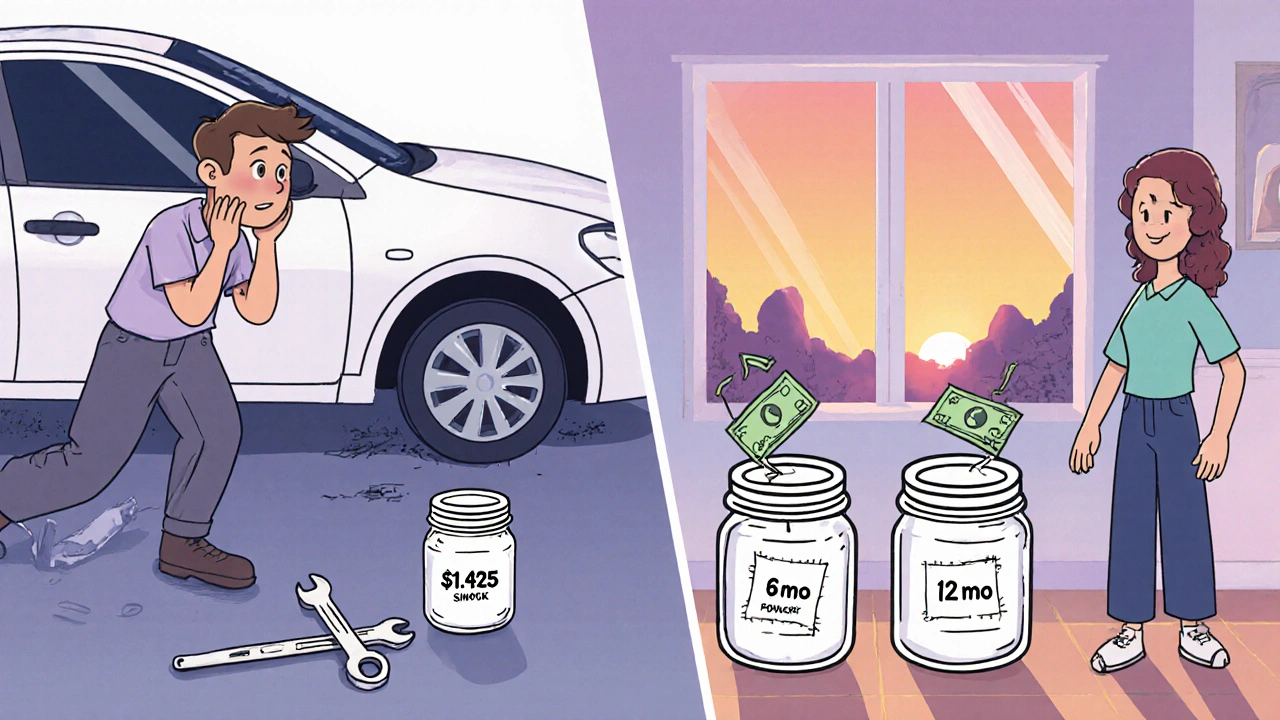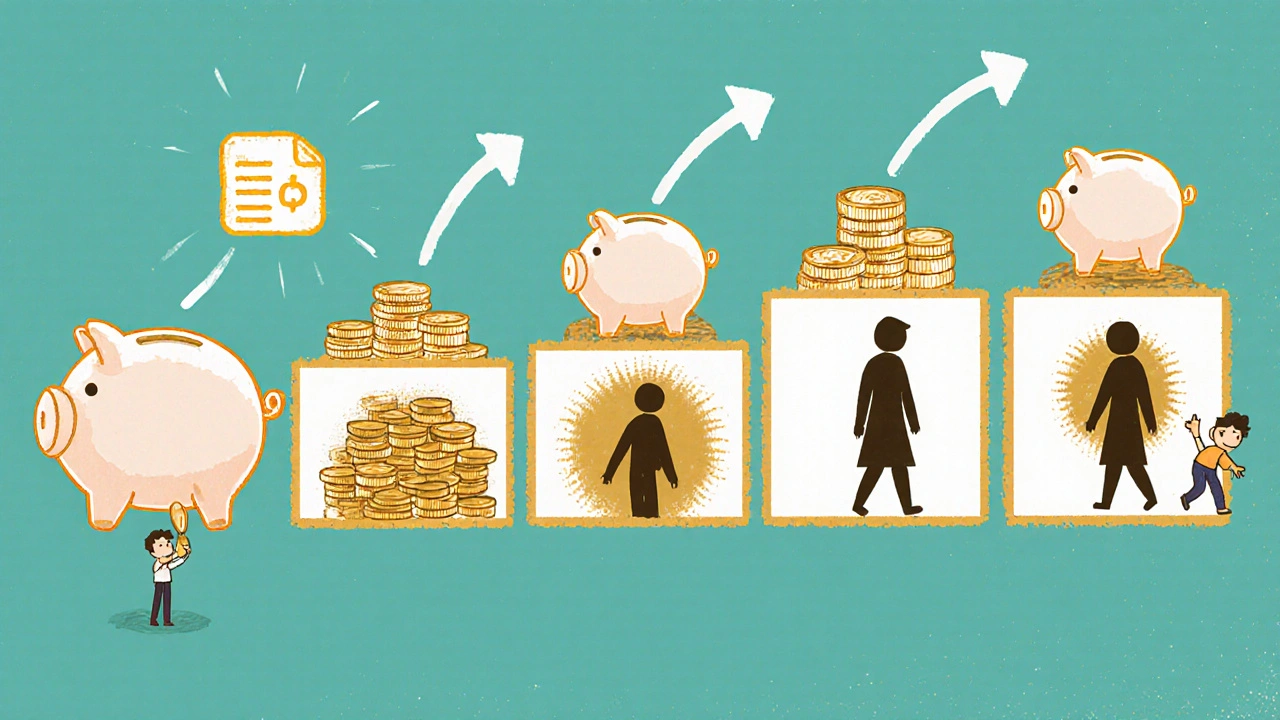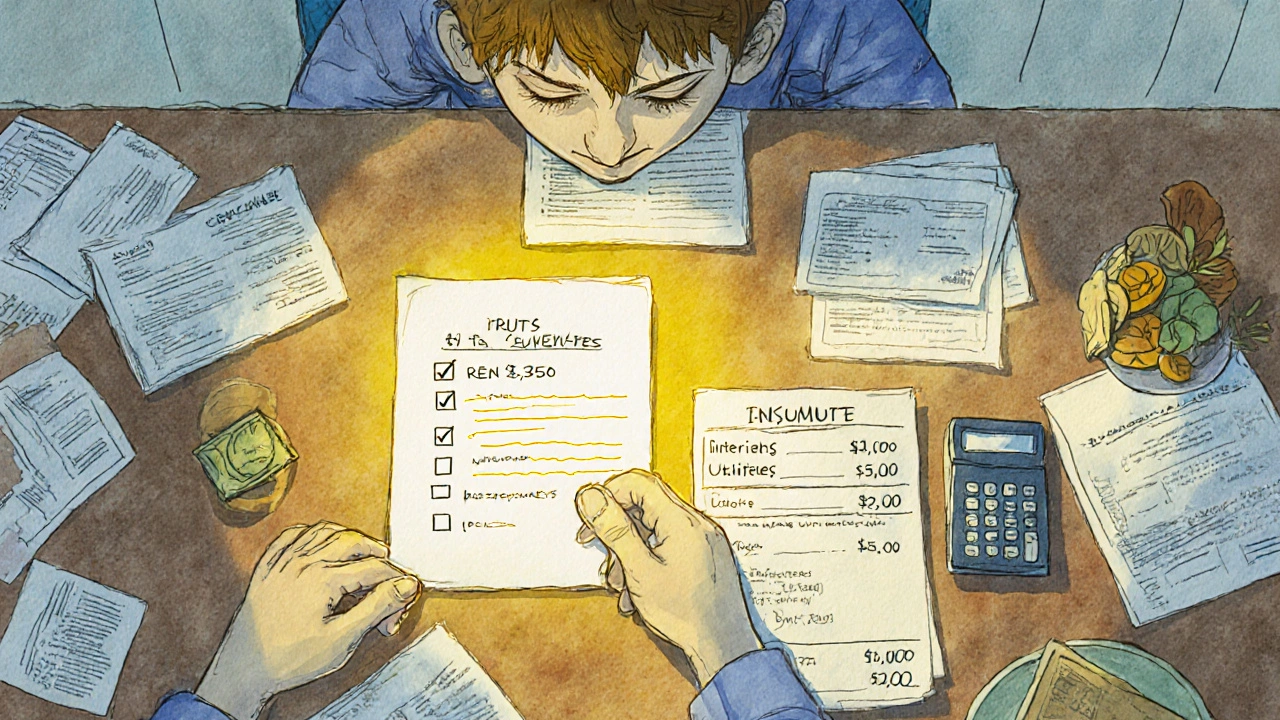Emergency Fund Calculator
Your Emergency Fund Target
Spending Shock Buffer
50% of your monthly essentials
Income Shock Buffer
Based on your risk level
Total Emergency Fund
Your personalized target amount
Your Savings Progress
Stop guessing. Here’s how to calculate your real emergency fund number.
You’ve heard it a million times: "Save three to six months’ worth of expenses." But what does that actually mean for you? If you’re making $4,000 a month and spending $3,200, does that mean you need $9,600? Or $19,200? Or maybe more? The truth is, that vague advice doesn’t work for most people. It’s too broad. Too vague. And it leaves you either saving too little or feeling overwhelmed trying to save too much.
The real answer isn’t a number you pull out of thin air. It’s a calculation based on your actual life, your income stability, your bills, and your risks. And it’s not as complicated as you think-if you break it down right.
Start with your essential monthly expenses-not your income
First, forget your take-home pay. That’s not what matters. What matters is what you have to spend every month to keep your life running. This isn’t about what you want to spend. It’s about what happens if your paycheck disappears tomorrow.
Here’s what counts as essential:
- Rent or mortgage (including property taxes and insurance if paid monthly)
- Utilities: electricity, gas, water, trash
- Internet and phone (if you need them to work or stay connected)
- Health insurance premiums
- Car payment and insurance (if you need the car to get to work)
- Gas or public transit costs
- Groceries (not dining out)
- Medications and basic healthcare
- Childcare or elder care
- Minimum debt payments (credit cards, student loans, personal loans)
What doesn’t count? Gym memberships, Netflix, subscriptions you can cancel, vacation funds, or money you put into savings for a new car. Those are optional. Emergency funds are for survival-not comfort.
Go through your bank statements from the last three months. Add up only the essential expenses. Don’t guess. Don’t estimate. Use real numbers. If your average monthly essential spending is $2,850, that’s your baseline.
Not everyone needs three to six months. Your situation changes the math.
The "three to six months" rule is a starting point-not a law. Your actual target depends on two big factors: how stable your income is, and how risky your life is right now.
Use this simple guide:
- 1 month if you’re a student, living with family, or have another income source (like a spouse with steady work).
- 3 months if you have a stable job (government, large company, union), no dependents, and good health insurance.
- 6 months if you’re self-employed, work gig jobs, are the sole income earner, or have chronic health issues.
- 8-12 months if you’re in a volatile industry (construction, retail, hospitality), freelance, or live in a high-cost area with no safety net.
Here’s why this matters: If you’re a freelance graphic designer who works with 5 clients and one of them cancels, you lose 20% of your income. That’s not a one-time shock-it’s a recurring risk. You need more cushion.
Or if you’re a single parent working retail with no paid sick leave? A kid getting sick could mean lost wages and emergency childcare. That’s two shocks at once. You need more than six months.
Break it into two types of emergencies
Not all emergencies are the same. There are two kinds:
- Spending shocks: Unexpected costs that pop up-car repair, medical deductible, appliance breakdown, home emergency.
- Income shocks: You lose your job, get laid off, or your hours get cut.
Most calculators treat them the same. But they shouldn’t.
For spending shocks, you only need to cover the most likely, most expensive things that could happen in the next year. A good rule: Save at least half your monthly essential expenses. So if your essentials are $2,850, aim for $1,425 just for surprise bills.
For income shocks, you need enough to live on while you find new work. That’s where the 3-12 month range comes in. If you’re confident you can find a new job in 30-60 days, 3 months is enough. If you’re in a tight job market or specialized field? Go for 6-12.
So your total emergency fund = Spending Shock + Income Shock.
Example:
- Essential monthly spending: $2,850
- Spending shock buffer: $1,425
- Income shock buffer (6 months): $17,100
- Total emergency fund target: $18,525
This isn’t just theory. A 2023 Vanguard study found households using this dual-shock method were 31% less likely to go into debt after a job loss than those who just saved "six months of expenses."

Start small. Build momentum.
Looking at $18,525 might make you want to quit right now. That’s normal. That’s why most people never start.
Here’s the secret: Nobody saves their full emergency fund in one go. You build it in stages.
- $500: This is your "mini safety net." Enough to cover a flat tire, a broken phone, or a small medical bill. Get this first. It takes pressure off your checking account.
- $1,000: Now you can handle bigger surprises-like a furnace repair or vet bill. This is where most people get stuck. Don’t skip it.
- One month’s essentials: $2,850 in our example. Now you can survive a missed paycheck without touching credit cards.
- Three months: You’re officially protected against short-term job loss.
- Six+ months: You’re in the safe zone.
Navy Federal Credit Union tracked 250,000 members who used this step-by-step approach. Those who followed the stages reached their full goal 2.3 times faster than those who tried to save the whole amount at once.
Where to keep your emergency fund
It’s not about earning interest. It’s about being accessible. No penalties. No waiting.
Best options:
- High-yield savings account (HYSA): Earn 4-5% APY. Instant access. FDIC insured.
- Money market account: Similar to HYSA, sometimes with check-writing.
Avoid:
- Checking accounts: Too easy to spend. You’ll use it for things that aren’t emergencies.
- CDs: Early withdrawal penalties kill the point.
- Investment accounts (stocks, ETFs): Too volatile. You can’t sell when the market’s down.
Open a separate account. Name it "Emergency Only." Set up automatic transfers. Even $50 a week adds up to $2,600 a year.
What to do when you use it
Using your emergency fund isn’t failure. It’s what it’s for.
But here’s the rule: Only use it for unforeseen, essential, and urgent expenses. That’s three criteria. You need at least two to qualify.
Examples of valid uses:
- Car repair needed to get to work
- Emergency dentist visit
- Home furnace breaks in January
- Job loss
Examples of invalid uses:
- Vacation
- New TV
- Buying a new phone because you want a better one
- Pay for a wedding gift
After you use it, you rebuild it. Treat it like a debt you owe yourself. Set a monthly goal to refill it-same amount you saved before.

Common mistakes that wreck your emergency fund
Most people think they’re doing it right. But they’re not.
- Mistake 1: Including credit card payments as essential. If you’re paying $800/month on credit cards, that’s not an emergency need-that’s a spending problem. Don’t build your fund around bad habits.
- Mistake 2: Using your 401(k) or Roth IRA as emergency cash. That’s a trap. You’ll pay penalties, lose growth, and hurt your retirement.
- Mistake 3: Overestimating your essentials. People add in dining out, hobbies, and "maybe" expenses. Real data shows 78% of users overestimate by 22-35%.
- Mistake 4: Waiting until you have "enough" to start. The best time to start was yesterday. The second best time is now.
Check your bank statements. If your essential spending is higher than you thought, adjust your goal. If it’s lower, you can aim higher.
What happens when you actually do this
People who calculate their emergency fund properly don’t just feel safer. They make better financial decisions.
A 2022 study from Baylor University found households using precise calculations were 43% more likely to keep their emergency fund intact during economic stress. Why? Because they knew exactly what they were saving for-and how much they needed.
They didn’t panic when the car broke. They didn’t max out their credit card when the job changed. They just pulled from the account, refilled it, and moved on.
That’s the power of a real number-not a guess.
Next steps: Do this today
You don’t need a fancy app. You don’t need a financial advisor. You just need 45 minutes.
- Grab your last three months of bank statements.
- List every essential expense. Cross out anything optional.
- Add them up. That’s your monthly essential spending.
- Decide: Are you stable (3 months)? Volatile (6-12 months)?
- Calculate spending shock (half your monthly essentials).
- Add it to your income shock number.
- Set your first goal: $500. Then $1,000. Then one month’s essentials.
- Open a high-yield savings account. Set up auto-transfer. $50 a week. Done.
That’s it. No more guessing. No more stress. Just a clear, personalized plan that fits your life.

Comments (4)
Dave McPherson
Oh wow, another ‘step-by-step’ guide that treats personal finance like a fucking IKEA manual. Let me guess-you also think ‘high-yield savings’ is the pinnacle of wealth-building? Bro, if you’re not investing at least half your emergency fund into TIPS or short-term treasuries, you’re literally paying inflation taxes. And don’t get me started on ‘$500 as a starting point’-that’s not an emergency fund, that’s a coffee fund with delusions of grandeur. Real talk: if your car breaks and you can’t cover it with a $2k buffer, you’re not broke-you’re financially illiterate. Stop glorifying minimalism. Build the damn 12-month buffer. Your future self will thank you… or just ghost you like your ex.
Julia Czinna
This is actually one of the clearest breakdowns I’ve seen. I used to think ‘six months’ was arbitrary until I calculated my own essentials-turned out I was spending $2,100/month on just rent, utilities, groceries, and meds. No gym, no Netflix, no takeout. The dual-shock model made so much sense. I started with $500 last year, then $1k, and now I’m at 4 months. It’s not glamorous, but when my furnace died in December, I didn’t cry. I just transferred the money. Also-yes, separate account. Named it ‘Don’t Touch Unless You’re Dying.’ Works.
Kenny McMiller
There’s a deeper epistemological layer here, y’know? The whole ‘three to six months’ paradigm is a neoliberal mythos-it assumes labor stability, access to healthcare, and cognitive bandwidth to budget. But what if you’re gig-working, undocumented, or managing chronic pain? The model collapses under structural precarity. Emergency funds aren’t about personal responsibility-they’re about social failure. We’re asking people to patch systemic holes with their own savings. And yet… I still used your method. My monthly essentials? $1,800. Spending shock? $900. Income shock? 8 months. Total? $15,300. I’m at $6k. Progress, not perfection. Still, the system’s rigged. But hey-at least I know how much I’m being screwed.
RAHUL KUSHWAHA
Nice guide 😊 I live in India, so rent is low but medical emergencies are expensive. I used your method and calculated $1,200/month essentials. Now saving $50/week. One month done. Thank you 🙏